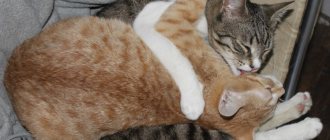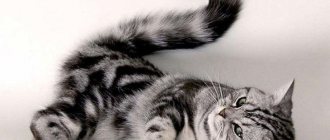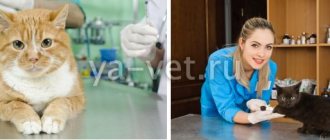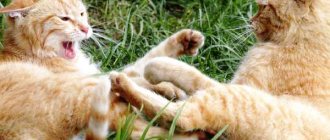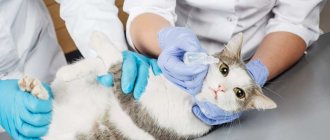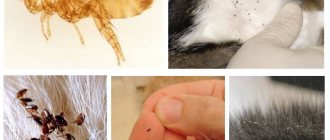Every owner is familiar with the situation when a cat asks for a cat. We answered questions about how long estrus lasts and at what age it begins, and whether sterilization is harmful. In the article you will also find a list of sedatives: herbal and hormonal. Find out what pheromonetherapy is.
With the onset of the first warm days of March, cat screams can be heard from the street, from which earplugs or a tightly closed window will save you. But these methods are completely ineffective when your cat asks for a cat in close proximity to you. You can wait until she gets bored, but there are better ways to take control of the situation.
Finding a partner is a natural need for cats.
Natural needs and sexual activity of cats
It is no coincidence that during the bright, warm spring and summer months we see an increase in the number of pregnant cats. As daylight hours increase in cats, the level of the hormone melatonin, produced in the dark, decreases. Which in turn affects the area of the brain responsible for the reproductive instinct. A reproductive hormone is produced, which ultimately leads to the cat immediately starting to look for a potential partner.
In veterinary medicine there is a special term - estrus - a period of sexual desire that lasts 5-7 days, rarely it reaches 14 days.
During this period, the cat uses vocals and secretions to attract a male.
One way to attract a male
In domestic cats, which may not leave their apartment all their lives, breeding cycles may not depend on the time of year and external factors, so estrus can make itself felt regardless of the season.
When to breed?
When cats start asking for a cat for the first time, everything is clear. But when are they ready for pregnancy? Physiologically, the pet will be ready to bear, give birth and feed offspring only by 16-20 months. This is explained by the fact that puberty is completed at approximately 1-1.5 years. It is important that the cat gets stronger and the pelvic bones are formed. Otherwise, there is a high probability of miscarriage or the birth of ugly and undeveloped kittens. The load on a fragile spine can lead to disability for the pet itself. But it’s also not a good idea to have a cat-to-cat accident too late. After all, late pregnancy can be harmful to health.
Let's look at when cats start wanting a cat for the first time. Their sexual maturity is complete at about 10 months. But, of course, everything is individual: in some individuals it may be earlier, at 6 months. The following signs indicate that the pet has started asking for a cat: enlarged genitals, frequent urination, the presence of colorless discharge.
The age at which a cat can impregnate a cat directly depends on his puberty. It is advisable to adopt a cat after he is one year old. A cat must mate at least 9 times a year. Otherwise, the hormonal system will malfunction and the animal will begin to mark its territory. Unlike cats, male cats are ready to mate all year round.
Signs that a cat is wandering
Often the signs are pronounced, reserved individuals are found, and it is possible to find out about puberty only after pregnancy.
So, during estrus characteristic behavior appears:
- rubbing against objects more often and longer than usual;
- frequent urination, especially when the cat approaches;
- clear vaginal discharge, left not only in the tray;
- the desire to get outside;
- loud screams with uncharacteristic howls;
- refusal to eat;
- unusually persistent affection towards the owner;
- unusual rolling on the floor, moving the tail to the side, tucking the paws.
Pills
The simplest option is to calm the animal using special tablets. Modern veterinary medicine can offer a choice of two types of drugs:
- calming;
- hormonal.
Let's look at these types in more detail below.
Calming
Sedative drugs are made on a herbal basis. Such tablets must be given to the cat several times a day so that the animal remains calm and behaves appropriately. The composition of calming tablets for cats includes the following herbs:
- mint;
- plantain;
- cottonweed;
- motherwort, etc.
How often does heat occur?
Theoretically, by their nature, cats can bear up to six litters per year, and estrus can occur much more frequently.
Cats may look for a mate every three weeks for a week. If mating does not occur, her body will continue to repeat the estrous cycle until pregnancy or sterilization. By the way, after giving birth in many animals, estrus begins after a month and a half.
During heat, cats may try to escape from the house.
The female cycle is directly related to the length of daylight hours. For cats living outdoors, the frequency of estrus increases from late spring to fall, and decreases as daylight hours decrease.
Domestic cats live year-round under artificial light and may experience almost constant hormonal activity.
Sedatives
If hormonal preparations cause concern among owners in terms of their effect on the health of the animal, then preparations of plant origin in the form of drops, collars, and fumigators do not affect the synthesis of sex hormones. They affect the cat's nervous system, but to be effective in sexual arousal, they must be used over a long period of time.
Before use, consult a veterinarian and follow the instructions. Do not use drugs intended for humans!
What period of time is it?
The estrus cycle consists of four stages:
- proestrus. Lasts 1-2 days, the cat shows anxiety, but does not allow the cat to come near it;
- estrus – estrus itself, expressed by frequent urination and loss of appetite, lasts 5-7 days;
- metestrus, extinction of the reproductive instinct, lasts up to 8 days;
- anestrus - a period of rest that occurs if mating does not occur, lasts until the beginning of the next cycle
Thus, the average duration of estrus reaches two weeks. At the same time, the “hunting” time increases with age.
One way to solve the problem of a restless cat who wants to procreate is to mate with a male cat. Despite its apparent simplicity, this process requires serious preparation.
The first mating can be carried out no earlier than the cat reaches the age of one and a half years, when the body is fully formed and the animal has received all the necessary vaccinations. Early pregnancy in cats often ends in failure, creating a risk to the health of the animal.
Mating a cat and a cat requires a thorough approach from the owners
The cat meets its partner on the 3rd-5th day of estrus, although in some breeds favorable days begin only in the second week. An animal that finds itself in a foreign territory for mating must be provided with comfortable living conditions; you can take with you a sleeping place, a tray, a bowl, or a favorite toy. This will ensure a reduction in stress levels.
The cat's readiness can be guessed by its characteristic flirting with the cat. Mating does not always occur on the first try; in case the animal becomes agitated, the owner needs to be nearby in order to be able to calm it down.
Unfortunately, mating is not always successful; the reason may be both psychological and physical incompatibility of partners. In this case, you can contact a specialist breeder or find another partner for the cat.
The practice of mating is also known not for the purpose of giving birth to kittens, but to satisfy the cat’s sexual instinct. In this case, a castrated cat is used, fertilization cannot occur, and the cat may not experience sexual desire for up to two months.
There are pills that can calm a cat that is calling.
Photo gallery
Photo 1. Scratching a cat's neck
Photo 2. Close-up of catnip
Photo 3. A rare period of calm during estrus
Calming a cat in heat
What should the owner do if the cat asks for a cat, but he is not ready for the birth of kittens, and surgical intervention is not considered. The solution may be one of three methods, which we will consider below.
Calming tablets
There are a number of medications on the market that can calm a cat during heat. But they can have a short-term effect and also cause an allergic reaction in the animal’s body. To achieve the best result without harming your cat, you need to consult with a specialist who can tell you exactly which drug is best for your pet, how much it will be needed, and how effective the treatment will be.
The table below shows some of the sedatives and their characteristics.
| Name | Release form | Category | Dosage |
| cat Baiyun | Drops | Herbal infusion | 2 ml (0.5 teaspoon), 3 - 4 times a day for 5 - 7 days monthly, or added to drinking water. |
| Sex barrier | Drops | Hormonal drug | animals up to 5 kg - 4 drops, over 5 kg - 5 - 7 drops |
| Fitex | Drops | complex of natural plant extracts on a water-glycerin basis | 1 drop of the drug per 1 kg of animal weight, 3 times a day |
| Gestrenol | Drops | Hormonal contraceptive | During estrus, animals up to 5 kg in weight - 4 drops, for 6-10 kg in weight - 5-8 drops |
| Gestrenol | Pills | Hormonal drug | 1 – 2 tablets for 4 – 5 days |
| Stop stress | Drops | Complex of medicinal plants + phenibut | 1 drop per 1 kg of animal weight 2 times a day |
| Stop stress | Pills | Complex of medicinal plants + phenibut | Animals up to 5 kg weight 0.5 tablets, over 10 kg - 0.5-1 tablet 2 times a day |
There are also long-acting chemical contraceptives
Suprelorin is a contraceptive bioimplant that is effective from six months to a year. Infertility occurs after 6 weeks from the start of use. It is an implant placed in the withers area under the skin; over time it is absorbed into the tissues.
Dermatonin and Ferretonin are melatonin implants, administered subcutaneously, ensuring the absence of estrus for the duration of implant resorption for 1.5-4 months. Melatonin reduces libido by simulating a period of calm during decreasing daylight hours.
Covinan injection with prolygestone as an active substance
The listed drugs have many contraindications and side effects and should not be used without a doctor’s prescription.
Traditional calming methods
In addition to medications, you can try traditional methods of calming a cat during estrus. These non-trivial methods can resolve the question of what to give a cat during estrus so that she does not ask for a cat. First of all, folk recipes include catnip, lemon balm, motherwort and valerian, which can be purchased at a regular pharmacy or pet store. Their effectiveness has not been proven, the cat will not stop asking the cat for a long time, but they certainly will not harm the body.
Catnip will help combat manifestations of activity during estrus
Many owners agree that physical activity helps cats cope with the symptoms of heat more easily. It is also recommended to reduce the amount of food, feed more often and in small portions, then the cat will be able to shift the focus of attention to more basic needs for some time.
To exclude external irritants, it is better, if possible, to temporarily isolate the cat from other animals during estrus.
Pheromone therapy
Pheromone is a volatile chemical substance with a natural composition through which animals exchange information. These substances are released from the body into the environment and can cause a particular reaction in the behavior of the individual that received the signal. For example, with the help of pheromones, marking territory, males “protect” their territory or warn of danger.
Pheromones can both excite the nervous system and calm the animal, including during estrus. These drugs are sprayed into the air, which makes the procedure for taking such a “medicine” humane.
The disadvantage of this therapy is the lack of guarantees of its effectiveness.
It's almost impossible not to notice changes in your cat's behavior
How to help a cat with folk remedies during the period of wanting a cat?
There are folk remedies that can be used when a cat wants a cat, in order to use them you need to know what, you need to prepare and how to do everything.
The most well-known methods are the following:
- Place the cat's rump in the water for a few minutes, keeping the water temperature relatively low. This will calm the cat for a while.
- It’s good to wet the cat so that after that she can divert her attention to licking herself. This procedure will take about 4 hours, so the cat will spend a lot of energy and will probably want to sleep. It is better if this action is carried out closer to night.
- An effective remedy is a weak vinegar solution that should be given to your pet.
- Veterinarians recommend masturbating the animal, imitating the cat's grip on the cat's withers.
- Lubricate the face with butter, which will give it the opportunity to be distracted by washing, which will also take a lot of time.
- Give your pet milk to drink, to which you should add soda at the tip of a teaspoon.
- Place a large copper plate in the container of water from which the pet drinks for the entire period.
- Give a closed bottle of valerian.
To calm the cat, you can dip it in water.
Above, only the main folk remedies were listed that help to cope with the problem of a cat's ora during the cat's period of desire. However, it is worth noting that they provide only a short-term effect. However, during this time, you and your pet will still be able to take a break and survive this very difficult time, as well as ease each other’s fate.
Sterilization: pros and cons
Owners have different opinions on the issue of sterilization. Some consider this operation to be the only right step towards the pet’s health; for others, it does not seem humane to deprive a cat of the opportunity to give birth to offspring.
It is worth noting that timely sterilization greatly reduces the risk of cancer.
The best time to perform the operation is considered to be the period before the onset of the first estrus or immediately after its end. Also, the possibility of developing breast cancer is reduced to almost zero. It is possible to sterilize at an older age, but then you need to consult a doctor to see if the animal will tolerate anesthesia.
As for deprivation of the right to give birth, such doubts are inherent only to humans. Animals live by instinct and do not dream of a large cat family since childhood.
The veterinary community has come to the conclusion that sterilization is absolutely safe for cats; the only contraindication can be the patient’s advanced age. But the operation once and for all relieves the cat from suffering, minimizes the risk of disease, and also guarantees peace of mind for the owner.
The disadvantages of sterilization include the recovery period. Since the operation is performed under full anesthesia, she needs careful care and attention over the next few days. In addition, changing dressings requires courage from the owner, although it is not difficult.
Kitty in a post-operative bandage
Also, sterilization requires financial investment, and for some owners it seems more convenient to buy medications that stop or reduce the cat’s sexual desire. But you need to understand that often this kind of drug intervention puts the pet’s health at risk.
It is also worth noting that there are often cases when, due to hormonal changes after sterilization, a cat may become less physically active, thus increasing the likelihood of gaining excess weight. But in this case, it is possible to take control of nutrition and independently provoke physical exercise in the cat, which at the same time will add joyful emotions to the animal and its owner.
general information
A cat reaches sexual maturity between its eighth and tenth month of life. It is at this time that the owners of the animal learn for the first time how their pet behaves during the mating season. Most cat owners expect unpleasant surprises: the animal’s behavior usually changes for the worse. From a calm and imposing cat becomes restless, aggressive, looking for something, aiming at corners. On top of everything else, a cat, clouded by “passion,” loses its appetite, as a result of which it noticeably loses weight.
And if cats come into heat only during certain periods: as a rule, once every 4 weeks, then cats with the onset of puberty can and are ready to mate constantly. If the cat is not bred, the logical solution is either castration or reducing the animal’s desire with the help of special drugs.
We note, however, that almost all drugs for cats labeled “anti-sex” contain hormones, so such drugs should not be abused. It is worth using hormonal-based drugs only in extreme cases, when it is necessary to calm the animal, and its behavior has already gone beyond what is acceptable and causes both the owners and the cat itself severe discomfort.
Reasons for lack of estrus
Among the reasons for a long-term lack of desire to mate are:
- predisposition caused by genetic breed characteristics;
- dysfunction of the thyroid gland;
- endocrine shift;
- pathological condition of the ovaries;
- hermaphroditism, etc.
There are emotional factors that cause sexual dysfunction. Lack of hunting is observed in individuals that are kept indoors, do not have contact with other representatives of their species, and do not observe normal sexual behavior.
Purebred females over one and a half years old who are involved in breeding require treatment to restore the normal functioning of the reproductive organs. Pets kept for pleasure do not need such treatment. The veterinarian will examine the pet; if other pathologies do not appear, treatment is not necessary. Periodic preventive examinations will be required.
Deviations from the norm
The owner needs to carefully monitor the seasonality, duration, and nature of estrus in order to record anomalies. A long absence of the active phase, its frequent occurrence, pain, sluggish response to treatment, yellowish discharge with an unpleasant odor, bloody inclusions indicate endocrine disruption and more serious health problems. If the first rut does not occur for too long, when estrus lasts longer than two weeks, consultation with a veterinarian is required. Signs of ill health must be combated with means recommended by specialists.
Prolonged heat
In this state, the duration of the physiological phases of the process increases. The continuous rut lasts more than two weeks, causing discomfort to the pet. A characteristic feature is the continued appearance of mucous discharge, accompanied by manifestations of aggression towards the male. Mating does not occur, fertilization does not occur, the mustachioed beauty remains excited. Prolonged stress makes the situation worse.
Anaphrodisia
This is the name for the condition of a fluffy beauty who is of childbearing age, but does not show any signs of sexual desire. Anaphrodisia (acyclia) is a characteristic sign of delayed puberty. If the female is not intended for breeding purebred offspring, she may not need treatment. The veterinarian examines the animal to rule out hyperfunction of the thyroid gland or adenohypophysis. If pregnancy is necessary, combination therapy with follicle-stimulating hormones is carried out: choriogonadotropin, folliculin, estrone.
False pregnancy
Only a veterinarian can accurately diagnose this condition. It is characterized by the same symptoms as for normal pregnancy:
- increased appetite;
- increased thirst;
- finding a secluded place;
- increased attention to small soft objects;
- swelling of the mammary glands;
- increase in abdominal size.
The problem is considered psychological and is seen as the result of prolonged stress. The sad result is purulent mastitis and similar diseases. Sphynx cats have an innate tendency to show signs of false pregnancy.
Empty heat
Lack of fertilization is not considered a normal condition. If your pet does not become pregnant, the body experiences unwanted hormonal stress. The situation is complicated by the substances that caring owners give to calm the cat at this time. In the future, there is a high probability of developing dangerous diseases: mastitis, hyperplasia, cancer, ovarian cysts, polycystic disease, endometritis, purulent inflammation, etc. If you do not plan to get offspring from a cat, timely sterilization will be a choice in favor of her health.
Frequent heats
The average norm is two to four rutting periods per year, although much depends on temperament, breed, and genetic characteristics. It happens that the re-rut occurs too often, literally every week or two. This dangerous condition cannot be ignored. If mating is not planned, you need to show the animal to a veterinarian. Perhaps this is a manifestation of a serious gynecological disease, for example, polycystic disease. Treatment with hormones can be effective. If the problem is not resolved, castration is the next appropriate step.
Bloody issues
The appearance of blood in mucous secretions indicates the presence of a serious pathology. It is impossible to determine the cause “by eye”; a serious examination by an experienced veterinarian is necessary: standard tests, histology, cytology, ultrasound, studies, the decision of which is made by a specialist. Some diseases develop rapidly. If you have bloody discharge, the most sensible step is to visit the clinic immediately.


